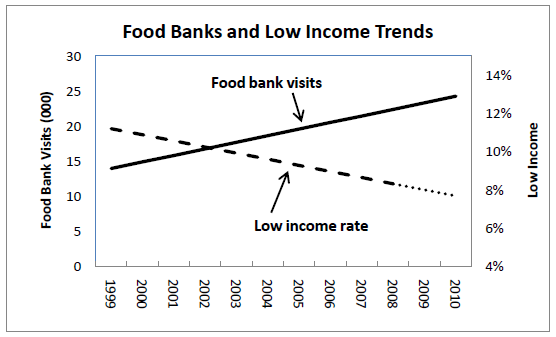Food banks and poverty – two different issues
Advocates claim that rising food bank usage is a symptom of hunger and poverty. In fact, poverty has declined significantly in Canada. Because of their chosen business model, it is inevitable that usage would increase. Food banks are voluntary social services, not an indication of government policy failure.
Read the full article below or click the button to download a PDF.
.
November 17, 2010
Food banks and poverty – two different issues
By Rick August
Food Banks Canada has just released its annual “Hunger Count”, a survey of food bank utilization across the country. The report shows that food bank utilization is rising, in both Canada and Saskatchewan.
Many people believe that food banks are a necessary evil, a community response to the failure of governments to address increasing poverty. The evidence, however, does not support the notion that food bank use and poverty rates are closely linked. Over the period the food banks have been collecting statistics, while food bank utilization has been rising, poverty has in fact been falling.
For example, in 1993 14.8% of Saskatchewan households were below the low-income cut-off. In 2008, the most recent year for which the statistic is available, the figure was just 7.2%. This downward trend has been quite consistent over the years.

If poverty is not getting worse, why are more people using food banks? The answer probably lies in the way food banks operate their service.
In simplest terms, the food banks give away free groceries. For this reason alone it would be understandable that they would become attractive to more and more people. This is a key difference between food banks and, for example, thrift shops, where modest prices act as a self-screening tool and reduce waste.
Food banks also do not directly assess users for need. They rely instead on external agencies to determine need and make referrals for food hampers. These referral agencies may not have the capacity to screen accurately for need, and have little incentive to say no to anyone.
Food banks also offer additional services that widen their attraction. The Regina Food Bank, for example, provides not only food baskets, but also a variety of employment and educational services.
The food bank movement equates rising utilization with more hungry citizens, but low-income statistics do not bear this out. It is much more likely that food banks create their own demand by offering an attractive service that is only broadly targeted to low-income people.
This does not, of course, make food banks a bad thing. Better nutrition is a worthwhile goal in itself. Lower food costs give families more flexibility within household budgets, and more capacity to cope with problems like rising housing costs.
Food service users may also take advantage of education or employment services, increasing their long term earnings. Food banks may reduce food wastage, which some sources estimate at over 25%. The food banks have also succeeded like no other social agency in mobilizing support of businesses and the general public.
The benefits of food banks should be appreciated in their own right, however. Given the current structure of the food banks, we should expect them to be a permanent part of our community social service system, and we should expect utilization to go up, independent of trends in the economy or government policies towards poverty or low income.
© RJ August, 2010
The author is a Saskatchewan social policy analyst who helped design and implement several provincial and national social programs, including the National Child Benefit.
________________________________
Statistics Canada low income cut-off statistics referenced in this item are after tax, 1992 base, which is the most appropriate of the LICO measures when considering the circumstances of citizens who rely heavily on public benefits. Food bank utilization linear trends are based on 1999-2010 Saskatchewan data from Food Banks Canada and calculated using the least squares method. There is considerable amplitude in the food bank time series. Low income linear trend estimates and projections are also calculated using the least squares method and based on Saskatchewan data from 1989 to 2008, from Table 202-0804 of Statistics Canada’s CANSIM database.
Contact
Contact Rick August for more information about this article.
